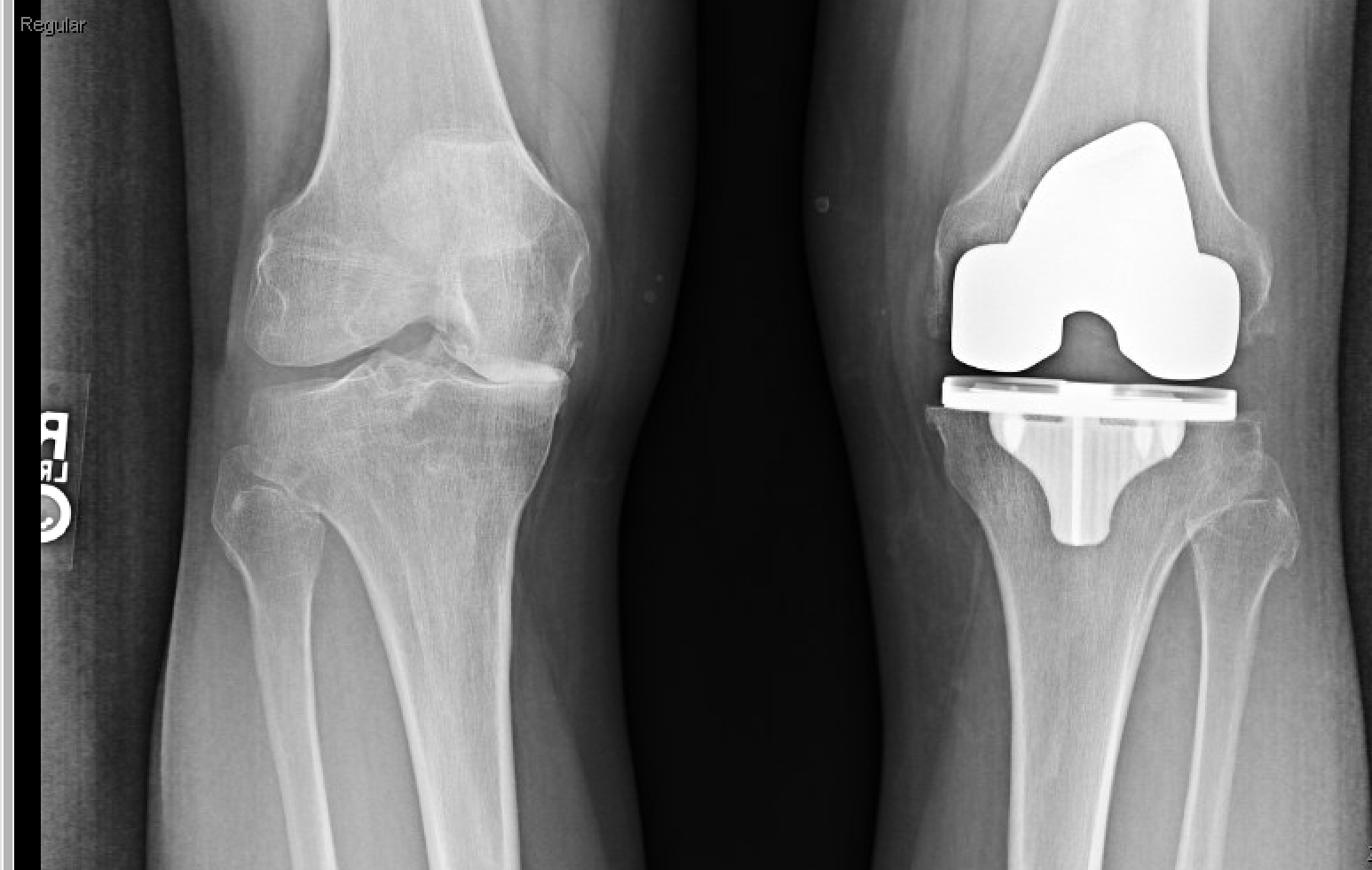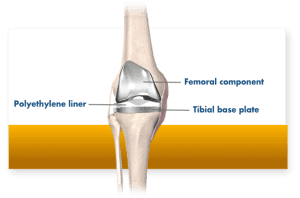Estes Park Health surgeon attacks knee pain on all fronts

Knee pain is an extremely common medical problem that can be caused by injury, wear and tear or arthritis. There are many approaches physicians can take to fix knee issues, from minor treatments to major surgery.
“The knee joint, even though it is a hinge joint, is a fairly complex joint that has a lot of different anatomical parts to it that can be fairly complicated,” explained Estes Park Health orthopedic surgeon Dr. Gavin Bishop. “The cause of pain with a knee can be multiple sources. Often people think that it is just arthritis, but there’s also a possibility that it could be a multitude of things.”

Total knee replacement is essentially a procedure in which the surgeon removes the old part of the knee and inserts a new device, replacing the joint surfaces with metal and plastic. (Graphic by Estes Park Health)
Some of the more common causes of knee pain include patella femoral syndrome where the kneecap is involved in a significant amount of force on the front of the knee.
“When we’re standing, it’s about two times our body weight,” Dr. Bishop noted. “When we’re going up and down stairs or hiking up a mountain, it’s about eight or nine times our body weight.”
Patients can also experience ligament or meniscus problems. These create stability and cushion for the knee.
When people come to see Dr. Bishop the first time, he must assess what is going on.
“The first thing we do is get a story, so we know how or where the pain or discomfort is coming from,” Dr. Bishop said. “We also get x-rays to evaluate the bony structures of the knee and then a good physical exam.”
Depending on the diagnosis, specialists have many interventions to try and ease the pain or discomfort.
“Physical therapy can be exceedingly helpful as far as strength around the knee and balance in the knee,” Dr. Bishop stated. “There are certain kinds of injections. Cortisone is one we use a fair amount, which is a strong anti-inflammatory which helps dull, aching pain within the knee. Another type of injection which is only approved by the FDA for the knee but is currently used for some cosmetics is hyaluronic acid. That, too, can help with some of the inflammation in the knee. Some people like to think of it as something that can help smooth out the knee. Another approach is a multitude of braces, everything from a neoprene sleeve to a brace that has struts and supports that can be helpful for the specific needs of that knee.”
Dr. Bishop also advises certain patients to use heat, ice, non-steroidal anti-inflammatories, or Tylenol.
A lot of these interventions can make knee problems like irritation or limited range of motion more manageable, especially in the case of osteoarthritis or degenerative joint disease where the cartilage is just worn down.
“However, we don’t have a way to bring the cartilage back,” Dr. Bishop emphasized. “The only surgical fix for that is a total knee replacement. We can try all those approaches until it isn’t working anymore. Then it’s ultimately up to the patient to decide if the next step is joint replacement.”
Total knee replacement is essentially a procedure in which the surgeon removes the old part of the knee and inserts a new device, replacing the joint surfaces with metal and plastic.
During the surgery, Dr. Bishop makes an incision right up the front of the knee, right over the patella. Underneath the next surface, he makes a curved incision around the patella to move the patella out of the way. Then he exposes the femur, the tibia, and the patella. He uses special devices to make accurate cuts of those bones. Then he places metal on those bones and then plastic in between at certain stress points so that the ligaments can function the way they are supposed to function.

“We don’t have a way to bring the cartilage back,” Dr. Bishop emphasized. “The only surgical fix for that is a total knee replacement. We can try more conservative approaches until it isn’t working anymore. Then it’s ultimately up to the patient to decide if the next step is joint replacement.” (Photo by Estes Park Health)
“The ultimate idea is to recreate the alignment and the function of the knee as it was originally designed by taking off as little bone as possible and putting on an implant that will recreate that joint,” Dr. Bishop explained.
Patients get up and move on the same day as their procedure. Mobility is important shortly after surgery to maintain that range of motion, so scar tissue does not develop. At two weeks, most people are walking (some with an assistive device). By six weeks, most people are walking without the assistive device.
“It’s the outcomes that are most valuable to me,” Dr. Bishop said. “I like it when patients do well and get back to the activities they enjoy doing like hiking and taking part in sports.”
One of the many advantages of having your total knee replacement surgery at Estes Park Health is being close to home. If you live in this area and your family and friends are here to support you, that can be extremely valuable in your recovery.
“I have years of experience doing joint replacements in Longmont,” Dr. Bishop added. “I have a large group of patients who have been very happy with their procedure. I’m excited to bring that same technology, that same ability, here to Estes Park. Come see me. It starts with a conversation. I’d be happy to see you. We would discuss what the main issues are, what’s bothering you, what things we can offer you to improve your activity and what you want to do in your life.”
To listen to a podcast featuring Dr. Bishop talking about knee pain treatment at Estes Park Health, go to https://blubrry.com/1471883/131985720/mountaintop-medicine-from-estes-park-health-estes-park-health-surgeon-attacks-knee-pain-on-all-fronts/.


